Marembo Micheal, Haiyang Yu, Shiqing Cheng, Elianny Palencia Yrausquin, Kamgue Lenwoue Arnaud
State Key Laboratory of Petroleum Resources and Prospecting, China University of Petroleum, Beijing, P.R China
Correspondence to: Marembo Micheal, State Key Laboratory of Petroleum Resources and Prospecting, China University of Petroleum, Beijing, P.R China.
| Email: |  |
Copyright © 2018 The Author(s). Published by Scientific & Academic Publishing.
This work is licensed under the Creative Commons Attribution International License (CC BY).
http://creativecommons.org/licenses/by/4.0/

Abstract
Despite of the discovery of tremendous amounts of fossil fuels like petroleum in the Albertine graben region, Uganda’s population majorly uses biomass as the source of energy for cooking and heating especially in rural areas. The charcoal production is carried out on a traditional scale with low efficiency. Considerations for alternative renewable energy resources like geothermal, wind, and solar have been made and the government has set up favourable policies to enable the smooth harnessing of these resources. Based on modified data from literature, the study predicted the future oil production rates and compared them with the renewable sources. This review study utilized courtesy visits, informant interviews, observations, simulations, and document reviews to analyse the need for a cleaner energy resource. Revenue obtained from oil production is expected to decrease as production takes centre stage in the future and therefore need to devise new means of sustainable source of energy that is environmentally friendly to support the ever-expanding Ugandan population. This study analysed the renewable energy status in Uganda and highlighted the energy security and future prospects put in place to cater for the increasing energy demands. Simulation results indicate that daily oil production rate is expected to drop substantially from 500 bbl/day to almost 0.672 bbl/day during primary production and will experience a boom when water injection begins six years after primary production with a rise from 0.672 bbl/day to a constant rate of 61.4 bbl/day. However, the oil resource will be depleted in the future hence need for clean renewable energy source. Findings based on field survey and comparisons with published literature indicate that demand for energy is higher at residential level than at commercial level while electricity consumption rates are high at industrial and commercial levels. Over 90% of Uganda’s population are involved in biomass burning mainly firewood and charcoal and electricity distribution majorly falls in the main towns with a huge deficit of electricity supply in the villages. The need for renewable energy in Uganda has been highlighted through comparison of future demands of fossil fuels and the renewable energy resources. The simulation study of the discovered fossil fuel in Uganda predicts future oil extinction thereby acting as a pivotal point for further research on affordable and renewable energy resources which are environmentally friendly with zero pollution.
Keywords:
Renewable energy, Energy security, Fossil fuels, Biomass, Green energy, Reservoir simulation
Cite this paper: Marembo Micheal, Haiyang Yu, Shiqing Cheng, Elianny Palencia Yrausquin, Kamgue Lenwoue Arnaud, Uganda’s Energy Security Based on Prospects, Challenges, Opportunities, Supply, and Demand towards Achieving a Green Energy-Reliant Environment, International Journal of Energy Engineering, Vol. 8 No. 2, 2018, pp. 40-51. doi: 10.5923/j.ijee.20180802.03.
1. Introduction
The world thrives on environmental quality and social equity backed up by economic growth and linked by energy. Uganda is a naturally gifted and landlocked country located in the Eastern wing of Africa neighbouring Kenya to the East, Tanzania to the South, Rwanda to the South-west, Congo to the West, and South Sudan to the North. The energy sector is steadily flourishing with the recent discovery of huge amounts of crude oil in the Albertine graben region of Hoima District, Western Uganda amounting to three hundred (300) million barrels of oil in the Kaiso Tonya area which covers only 5% of the entire prospective belt covered by 20% sedimentary rocks. The discovery of the fossil fuel comes as a blessing to the country with the government revenue expected to increase (Ezra Suruma, 2010). However, to effectively tap this lucrative resource, many inherent factors have to be considered which might affect both the environment and the country’s GDP. The ultimate question is what to use the oil revenue for: investment or consumption. Also another area of concern is about the usage of the resource in ensuring a pollution-free environment since fossil fuels are associated with enormous greenhouse gas emissions. (In addition to the above, will the oil sustain the Ugandan energy industry for years to come? To tackle these questions, the government should embrace the opportunity to harness the oil but also keep in mind of the curse the oil might bring along (John Hassler, 2013). These are pivotal areas for increased research on renewable energy which is deemed abundant and always readily available. According to International Energy Agency (IEA), in order to curb greenhouse gas emissions and mitigate climate change, renewable energy is expected to increase its share in the global energy mix now driven by fossil fuel consumption (IEA report, 2011). Uganda is endowed with renewable energy sources like biomass, wind, geothermal, hydropower. Geothermal resources have been discovered in the Kibiro area and Panyimur area and exploration works have already began with the installation of micro-seismic equipment to aid locate the exact spot for tremendous geothermal exploitation which will solve the current rampart power shortage problem (Godfrey Bahati, 2008). Currently, the country’s geothermal resources are estimated to be about 450 MW (Godfrey Bahati, 2008). For decades, the population has been burning renewable resources estimated to account for 90% of the energy in Uganda (Muloni Irene, 2012, Biryabarema Elias, 2014, Bariyo Nicholas, 2013, Saundry Peter, 2009). The beautiful waters that flow from all corners of the country, provide hydroelectric potential which has not been put to effective utilization. In an effort to become energy self-reliant, the government of Uganda has established favourable policies that encourage energy security. According to the ministry of energy and mineral resources, in the 1980’s, burning of charcoal and fuel wood occupied more than 95% of the Uganda’s energy needs and by 2050 energy demands will quadruple (O. Broad and M. Hankins,2015, H. E Trends, 2007, Oting William Kamis Avellino, 2018). However, by 2005, Lake Victoria became the main source of the country’s electricity generation point. According to the Uganda bureau of statistics, by 2016, around 20% of the homesteads had access to hydro-electricity. A report released by the Uganda electricity regulatory authority as of February 2015 indicated an installed electricity capacity of around 810 megawatts with peak demands of 509.4 megawatts reducing the earlier load shedding issues almost close to zero. As of 2017, the country’s generation potential increased to 950 megawatts (Uganda bureau of statistics). The ministry of energy and mineral development forecasts that by 2019, the electricity generation capacity will hit 1900 megawatts. The country also boasts of two heavy fuel-oil thermal power stations located in Namanve with a 50 megawatt capacity owned by Jacobsen Electricity Company Uganda limited, and the Tororo station with an 89 megawatt heavy fuel-oil plant owned by electro-maxx limited. These thermal plants are used as standby plants in case there is load-shedding from the hydro-power unit. The sugar factories in Uganda also contribute to the national grid. The oil sector which is anticipated to begin production in 2020 has drilling, exploration, and development processes going on in the kingfisher well, block 3A. Currently, the country relies on imports of oil and gas from the producing countries. The country imports 18,180 barrels per day of oil through Mombasa port of Kenya (Robert Tumwebaze et al.).
2. Methodology
This review is based on the challenges and opportunities the Ugandan energy sector has since then encountered through a thorough analysis of both the broad-sectors and the sub-sectors with in the energy sector in Uganda. The sub-sectors include power, petroleum, new and renewable sources of energy, and Atomic energy. Issues salient to the energy sector in Uganda were explored through qualitative methods of data collection, analysis, document reviews, courtesy visits, and key-informant interviews especially in the energy hit rural areas. Document review process involved comprehensive analysis of documents and published literature about the aforementioned sub-sectors. The documents reviewed were ministerial reports, strategic plans, budget reports, policy documents, and work published by other researchers. The courtesy visits and key informant interviews were conducted on selected private companies operating in Uganda and the nationals.
2.1. Key Energy Issues and Opportunities in Uganda
In this section, the review highlights the existing development trends and challenges in the Uganda’s energy sector based on individual sub-sectors.
2.1.1. Power
This sub-sector covers electricity generation, transmission, and distribution. The 1999 electricity act established the electricity regulatory authority to regulate the industry (ministry of energy and mineral development, Uganda). The generation, transmission, and distribution are handled by Uganda electricity generation company limited (UEGCL), Uganda electricity transmission company limited (UETCL), and Uganda electricity distribution company limited (UEDCL) respectively. Uganda’s electrification rate is very low with the majority in villages still in dark zones. The government has set up a total of 1115 km of 132 kv high voltage transmission lines and 54 km of 66 kv countrywide (Irene Muloni, 2016, Robert Tumwebaze, 2011). The power export to neighbouring countries stands at: Kenya 30MW during the off-peak hours, Tanzania 9MW, Rwanda 5MW (Irene Muloni, 2016). According to Robert Tumwebaze et al. 2011, Uganda’s hydro-electric power potential is high with large power generation plants in Nalubale complex, Mukono district with an installed capacity of 180 MW and kiira with 200MW, Bujjagali hydropower project on river Nile, and Karuma hydropower project. While small hydropower plants are traced in various parts of Bugoye, Kasese District with an installed capacity of 13MW, Mobuku phase I in kasese with an installed capacity of 10MW, Mobuku phase II in Kasese district with an installed capacity of 5.4MW, and Kisiizi in Rukungiri district with an installed capacity of 0.29MW (Robert Tumwebaze, 2011). The investment opportunities in the power sub-sector have pulled a host of private investors to run and operate both the large scale and small scale fields. Courtesy visits and interviews focused on comparing power tariffs as of 2018 with those of the fourth quarter of 2017 by relevant consumers.
2.1.2. Petroleum
Currently Uganda relies on importing petroleum products which are routed through Kenya and Tanzania (Robert Tumwebaze, 2011). In September 2002, Heritage oil took the initiative to announce the first oil exploratory well in Block 3 of the semiliki valley, Albertine Graben basin, western Uganda (Robert Tumwebaze, 2011, MEMD, 2008). By July 2007, Tullow oil took on the exploration and estimated over 13893 barrels per day from the kingfisher-1 while Nzizi 2 appraisal well confirmed presence of 14 million cubic feet per day of natural gas (Robert Tumwebaze, 2011, Fritsch, 2008). The Albertine graben is the most probable field for high petroleum exploration prospects. This is still in its infant stages with exploration and development still going on in the oil rich areas of western Uganda. The sub-sector has so far the up-stream and down-stream sections. The up-stream is concerned with exploration, development, and production of the hydrocarbon and the down-stream is involved in transportation of the crude oil, refining, storage, distribution, and marketing of the hydrocarbon products. The Albertine graben harbors the natural resource and the current policies favour the development of the resource (Ulie Magnihild Grøtnæs, 2014). The government recently collaborated with Tanzania government to build a pipeline and the current consumption of imported petroleum products in Uganda is at 550,000 m3 (Irene Muloni, 2016). The review highlights the future trend of the oil industry as compared to the renewable energy prospects. Since the oil fields are still in appraisal stages and no production data available for concrete prediction of future oil rate and revenue, this review modified literature from various sources including Rafael et al. 2012, to predict the future oil production rate and time of well abandonment. Table 1 highlights the parameters used to conduct the simulation and prediction using compositional simulator CMG-GEM. Since information on the reservoir fluid components was not available, water was considered as the only fluid and a 10 year oil production forecast from 2020 to 2030 was conducted. The model area is 217800 ft2 and the rock type is sandstone conglomerate water wet. Oil recovery factor during primary production was compared to oil recovery factor during secondary production in order to draw future prediction conclusions.Table 1. Petro physical rock properties (Modified data from Rafael et al. 2012)
 |
| |
|
2.1.3. Renewable Energy
These freely available resources in Uganda are traceable in areas of woody and non-woody biomass, solar, wind, geothermal, and hydrological resources (Godfrey Bahati, 2008). The biomass sources including firewood, charcoal, and crop residues play a significant role in the country’s energy consumption with over 90% (Agnes Alaba, 2008, Sarah Nafuna Mudoko, 2013). Majority of the people trade in burning wood for charcoal to earn a leaving and charcoal is widely used as the main source of energy for cooking food and heating across the country (Irene Muloni, 2018). The government has however undertaken some measures to help conserve the dying environment from the tree cutters and has promoted use of improved stoves, afforestation (geo, 209). Solar is tapped directly from the abundant all-weather sunshine up to about 4-5 kw/m3/day (Alfred wandera and Samuel sanya). The solar is widely used for water heating, cooling, and crop drying. However, a few of the population can afford to use solar technology hence its usage is not wide spread. Wind energy is another source of energy in Uganda with an average wind speed of 3 m/s and goes up to 6 m/s in flatter areas around the Lake Victoria and Karamoja. Wind energy is mainly tapped along the lake shores to turn turbines and thereby producing electricity. Geothermal energy exploitation is in the pipeline since evidence of the resource exists. Potential geothermal resources are estimated at around 450 MW in the Ugandan rift valley areas however, no detailed studies have been carried out of late to estimate the future of the resource (Godrefy Bahati, 2008). In addition, Uganda also has non-renewable resources like bio fuel and fuel wood. The data collection involved house to house interview especially in rural areas, analysis of documents.
2.1.4. Atomic Energy
The government has limited usage of this resource only to the health and agricultural sector due to hazardous effects associated with the resource (Irene Muloni, 2018).
2.2. Concepts of Energy Security and Uganda’s Energy Security Policy
The current industrialization pressures from within and reference with other countries have awakened the government of Uganda on energy security issues. Energy security is a broad term tracing its hidden meaning in foreign policy and national security and is defined as the uninterrupted availability of energy sources at any affordable price (International energy agency, 2018, Chester, 2009, Bradshaw, 2010, Kiuk, 2011, Zhang Jian, 2016). Energy security covers long-term energy security which deals with on time investments in line with sustainable environment demands and short-term energy security which considers the energy system as a flexible tool to changes in demand and supply. The energy sector in Uganda is still developing and with prospects to reach the global self-reliant demand and has seen the government commission a number of projects on hydro, solar, geothermal, thermal, oil and natural gas with favourable policies (Sarah Nafuna Mudoko, 2013). The energy policy for Uganda established in 2002 aims to meet the energy needs of Uganda’s population in an environmentally affordable manner with clear objectives to cub down the environment related issues and accelerate economic development, the renewable energy policy established in 2007 focuses on providing an energy-diversified economy with vision 2040 to ensure all Ugandans are connected to the national grid (Sarah Nafuna Mudoko, 2013, Irene Muloni, 2017). The accelerating Uganda’s rural electrification and rise in renewable energy resources are the key areas for the energy growth in Uganda (Irene Muloni, 2017) According to the international energy agency report released in 2007, Uganda government was to increase the share of renewable energy from 4% to 61% of the national energy consumption by 2017. Among the strategies the government has undertaken to ensure energy security are;1. Providing favourable policies to enable the smooth exploration and development of the Albertine graben, oil rich region and the Kibiro geothermal rich region.2. Continuous research and development on possible future prospects.3. Diversifying the energy resources through use of both renewable and non-renewable sources.The market plays an important role in tackling the energy security issue with respect to the prevailing resources (international energy agency, 2016). Uganda has both fossil fuels, biomass, and renewable energy. The fossil fuels existing in Uganda are the recently discovered crude oil deposits in the Albertine graben. The biomass includes the trees, shrubs, animal, and agricultural wastes. The renewable energy include solar power, hydropower, Geothermal, wind, peat, thermal. From the categories above, the Ugandan population especially in the villages rely heavily on the traditional biomass through burning of wood, shrubs, animal wastes, and agricultural wastes. The energy supply and demand should balance if energy security must be ensured (iea, 2018). The revenue obtained from the hydropower exported to the neighbouring country, Rwanda would help in identifying the supply concept with respect to the demand concept based on the energy supply and demand equilibrium equation by Zhang Jian, 2016 below, | (1) |
From the above equation, stabilizing the energy prices and minimizing price fluctuations play a key role in establishing a reliable energy security platform. The government of Uganda plans in the same aspect to export part of its locally produced oil and consume some. This will reduce on the annual expenses on the importation of crude oil and natural gas. The respective terms in equation 1 are defined as follows, t is the predicted time,  is the total summation of the energy supply at time t, n is the number of the exporting countries, m is the number of importing countries, x is the energy importer and y is the energy exporter,
is the total summation of the energy supply at time t, n is the number of the exporting countries, m is the number of importing countries, x is the energy importer and y is the energy exporter,  are the existing proven reserves at time t,
are the existing proven reserves at time t,  is the output of energy for the importer or exporter., Pt is the energy price, Rdt is the risk factor and Rnst is the non-systematic risk factor.
is the output of energy for the importer or exporter., Pt is the energy price, Rdt is the risk factor and Rnst is the non-systematic risk factor.  is the total summation of the energy demand at time t.To analyse the energy security based on the supply side, the following dimensions are considered, time span, fuel variety, proved reserves, and quantitative volume, on the basis of the hydrocarbon resources. To bring other energy sources into play, the government of Uganda should aim at integrating the above dimensions with respect to the time span through, conserving the energy efficiency, building strategic hydrocarbon reserves, diversifying imports to bring in other renewable sources to the country, and effective management of the market.
is the total summation of the energy demand at time t.To analyse the energy security based on the supply side, the following dimensions are considered, time span, fuel variety, proved reserves, and quantitative volume, on the basis of the hydrocarbon resources. To bring other energy sources into play, the government of Uganda should aim at integrating the above dimensions with respect to the time span through, conserving the energy efficiency, building strategic hydrocarbon reserves, diversifying imports to bring in other renewable sources to the country, and effective management of the market.
2.3. Uganda’s Energy Security and Policy Strategies
According to the ministry of energy and mineral development, the policy goal is to meet the energy needs of Uganda’s growing population for social and economic development in an environmentally sustainable manner.1. Recognizing linkages between the energy sector and other sectors. This is because the energy sector significantly affects the beautiful environment either directly or indirectly.2. Seeking compatibility with the global and regional energy policies to acknowledge energy trends.3. Decreasing dependence on oil imports from oil producing and exporting countries. Oil production projections and future prospects, a pivotal point for increased research on renewable energy resources.Table 2 below shows the future trend of oil in Uganda with respect to the annual revenue based on modified data from the Economic policy research centre (EPRC) Uganda annual reports and publications.Table 2. Uganda oil prospects. (Source: Anticipation based on Economic policy research center (EPRC) Uganda report, 2016)
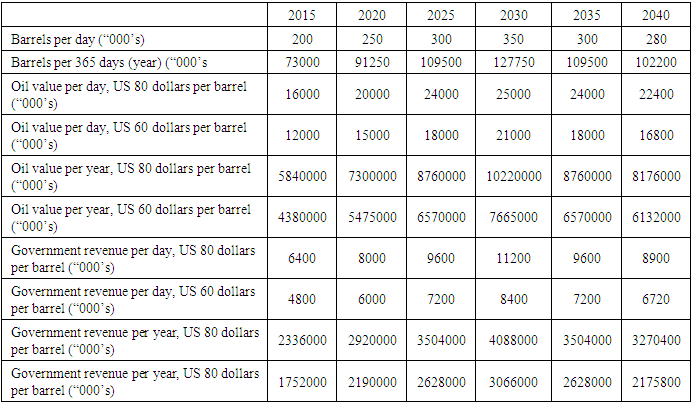 |
| |
|
From fig. 4 below, the oil production rates per day and per year coupled with the respective value of oil per barrel of production and government revenue are predicted. It is evident that, during the years from 2015 to 2020, the value of oil is almost insignificant since between this time, production has not yet begun, when production begins, the oil value rated at US dollars 80 (US$80) will be significant and will receive a boast which will deteriorate as production goes on. The government revenue is expected to rise sharply during the first years of production up to a maximum point beyond which it starts declining with a decrease in oil production rate. This therefore means that exploring into the alternative means of energy production would be beneficial to the Ugandan government in ensuring a stable energy supply through a wide scope of both renewable and fossil fuel especially geothermal and hydrocarbon gas production which is the basis for this study. This study therefore aims at analysing the current energy trend in Uganda.
2.4. Demand and Supply Policies from the Energy Sector
2.4.1. Demand
Energy demand in Uganda mainly results from a prominent GDP rise of about 6% for the last decades (Irene Muloni, 2018). The energy and electricity demands in Uganda are summarized in table 3 below.1. Individual household and institutions. The government has provided affordable energy services for the households, community based ranging from public lighting to affordable communication through providing incentives on electricity and modern fuels.2. Industry and commerce. Trainings have been conducted on energy usage.3. Transport. Fiscal policies have been formulated that favour the transport sector in terms of energy usage.4. Agriculture. Majority of the Ugandan population heavily rely on agriculture and so based on this Fact he government has implemented modern energy use to effectively eradicate poverty.Table 3. Energy demand comparison
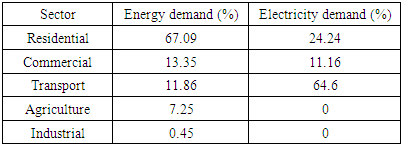 |
| |
|
According to a report released by the electricity regulatory authority, Uganda, as by the end of 2017 in quarter four, only 2240747 KWh and 759734 KWh were electricity purchases under the rural electrification company for the commercial and industrial sectors respectively.
2.4.2. Supply
1. Power. Incentives have been put to attract the private investors to tap into the Uganda’s ever expanding energy opportunity and rural electrification program was implemented.2. Petroleum. The government has put policies to govern the effective development of the upstream and the downstream sectors.3. Renewable energy. Has been included in the school curriculum to further understand the importance of the renewable resource.From fig.9, it is evident that the Ugandan population mainly uses biomass at 91.09%.
2.5. Renewable Energy Use Compared with Fossil Fuel Use-The Need for Renewable Energy in Uganda
Uganda is naturally endowed with vast amounts of renewable energy sources like wind, geothermal, biomass. Geothermal energy has not been put to use in Uganda to date though the history of abundance resources of geothermal energy trace back 4500 million years ago and is expected to carry on for more billion years to come (Godfrey Bahati, 2008) The Uganda’s population majorly uses biomass like burning trees for charcoal to use in cooking. Biomass energy from non-woody feedstock has a tremendous potential for utilization in the country (Table 7). Brieland Jones et al, 2015 analysed the social and environmental impacts of charcoal production in Liberia and observed that an exclusive focus on modern energy services must be redirected to consider the traditional energy sources. The table 4 below shows annual production of agricultural residues in Uganda. Hydroelectricity has for long been tapped from river Nile under the bujagali dam project but recently many other dams have been constructed. The electricity usage is depicted in table 6. While table 5 compares the different energy consumption rates in Uganda. Table 8 compares the advantages and disadvantages of fossil fuels and renewable energy resources.Table 4. Annual production of agricultural residues (source: Uganda renewable energy policy, MEMD, 2007. Retrieved from national charcoal survey)
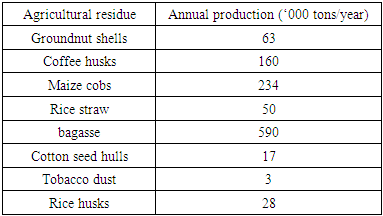 |
| |
|
Table 5. Energy use comparison in Uganda
 |
| |
|
Table 6. Electricity usage in Uganda
 |
| |
|
Table 7. Biomass usage in Uganda
 |
| |
|
2.6. Future Energy Prospects in Uganda and Way Forward to Harnessing Natural Opportunities
1. To avoid the greenhouse emission gases, the government has embarked on utilizing the renewable energy through developing the geothermal reservoirs. The geothermal reservoirs discovered in Kibiro, Hoima and Panyimur, Nebbi are estimated to produce 450MW which is likely to solve the power shortage problems. 2. Ensuring quality reservoir characterization to maximize recovery potential of the reservoir for the oil sector.3. International collaboration with energy rich countries like China.4. Further improvement in research and development towards achieving green energy that is environmentally friendly.5. Accelerating infrastructure construction and encouraging technology.6. Application of machine learning technology in reservoir characterization.7. Further research on hydrogen as a new kid on the block in the energy fraternity should be given priority.8. More research on geothermal energy need to be done based on the existing hot springs in Bunyoro, kasese, Kabale and other areas.9. Need to integrate the transport, energy, information, and humanistic areas.10. Innovative thinking through technological, management, institutional, and policy support.11. Increasing access to modern affordable and reliable energy service.
2.7. Challenges
1. Lack of capacity to effectively predict the climate change impacts on the different energy infrastructure and to adequately improve the green energy standards through limiting the use of biomass especially in villages.2. Biomass energy source remains dominant mainly at household level through cooking. This calls for the supply side to be effectively managed.3. There is low energy generation capacity to meet the increasing demand from the ever-expanding Ugandan population.
3. Results and Discussion
From the collected information and courtesy visits, the findings from the individual subsectors coupled with recommendations for Uganda’s future energy growth are hereafter highlighted. The energy sector in Uganda has received massive transformation from a national setting to a global setting in a bid to attain a green energy environment. However, the sector still faces a number of challenges which this review tackles based on the courtesy visit, existing literature, and interview reports from the conducted survey. The power subsector is associated with high power tariffs which majority of Ugandans living in the rural areas have up to now failed to adopt to thereby resorting to other sources of energy. Figure 1 indicates that there is an imbalance in power tariffs as levied on various power consumers. Domestic consumers pay Ushs. 718.9 per kWh which is a 4.9% increase from the tariff of the fourth quarter of 2017, commercial consumers including small scale industries pay Ushs. 648.3 per kWh reflecting an increase of 4.7%, tariff for street lights rose by 4.8% to Ushs. 701.9 per kWh, medium industries pay Ushs. 592.5 Per kWh which is a 4.3% increase, large industries pay Ushs. 375.5 showing a 2% increase from the previous year tariffs while the extra-large industries pay Ushs. 371.1 Per kWh indicating a 1.8% increase. The petroleum sector is expected to boost Uganda’s economy with improved government revenue. However the oil revenue will decrease sharply in the future when the pressure of the production wells will no longer support increased recovery. From figure 2, it can be seen clearly that the daily oil production rate will keep decreasing until a time when there is no more oil being produced with more water being produced during primary production, when water injection starts six years after commencement of primary production, the oil recovery factor dramatically increases to a maximum rate of beyond which it begins declining. Further enhanced oil recovery methods would enable boost the pressure of the reservoir to produce more oil. The daily oil production rate raises to a maximum of 500 bbl/day when the well is put to production and drops considerably to almost 0.672 bbl/day, while the oil recovery factor is 11.1% and the cumulative oil production amounts to 207598 bbl during primary production. When water injection starts after six years of primary production, the oil recovery factor suddenly increases from 11.1% to 28%, the cumulative oil production increases from 207598 bbl to 519742 bbl, while the daily oil production rate increases to a constant value of 61.4375 bbl/day as shown in figure 3. The future of oil production is anticipated to experience a drastic shock of oil extinction even with more wells being drilled. This calls for further research on renewable energy resources. Renewable resources would help solve issues associated with the uncertainty of future oil reserves and revenue. From figure 5, it is evident that at residential level, the energy demand is higher at 67% and the electricity demand is lower at 24%. This is mainly because the majority of the population mainly in the rural areas uses traditional energy resources like firewood and are not connected to the national electricity grid. Commercially the demand for improved energy resources and electricity tallies while in the industrial sector the demand for electricity is high. The transport sector shows lower demand limits for energy. Energy security issues continue to pose challenges to the Ugandan government both in the short term and in the long term irrespective of the recent boom in the oil sector. The majority of the population depend on the renewable energy sources basically wood burning, shrubs. Over 90% of Uganda’s population depend on Charcoal burning and use of Charcoal as a faster and cheaper means of cooking and heating. Minority of the population especially in the rural areas have access to the electricity supply. But the government has set up rural electrification program to extend the power supply even to the rural areas. To pervert this, the government has put favourable policies to enable the exploration of geothermal reservoirs that will help sustain the economy through a greener energy perspective. Charcoal burning in Uganda is at its peak with most of the people involved in the business to earn a living. Electricity distribution has over years seen a tremendous boom with more dams being built and in the urban areas consumption increased from 5.6% in 1991 to almost 15% in 2017 but the rural areas still remained at low consumption rates with a current rate of only 7% as shown in figure 8. From figure 9, firewood forms the main type of biomass consumed in Uganda at 78%, Charcoal at 5.6%, and crop residues at 4.7%. This is because the policy in Uganda encourages plant a tree-Cut a tree program and most of the forests available are privately owned. Biomass forms the major source of energy to date in Uganda at 90%, Electricity at 1.4%, while Oil products which are mainly used in the transport industry to run vehicles are at 9.7%. According to field information gathered, the government has encouraged use of modern cooking stoves, efficient light technologies, and ovens to promote a green environment. However, the energy capacity is still low. There is need to research more about natural gas production and usage. Natural gas and geothermal when put to use would not only promote a green energy and reduce on the current costs of importing the natural gas from the producing and exporting countries but also would be affordable to the majority of the Ugandans and would hence solve the load shedding problem accruing from the hydro power.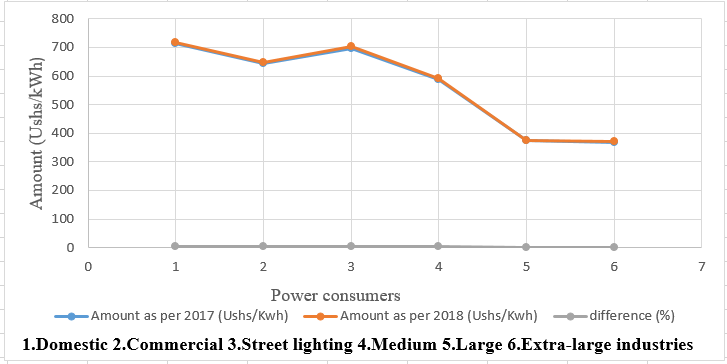 | Figure 1. Power consumption tariffs in Uganda |
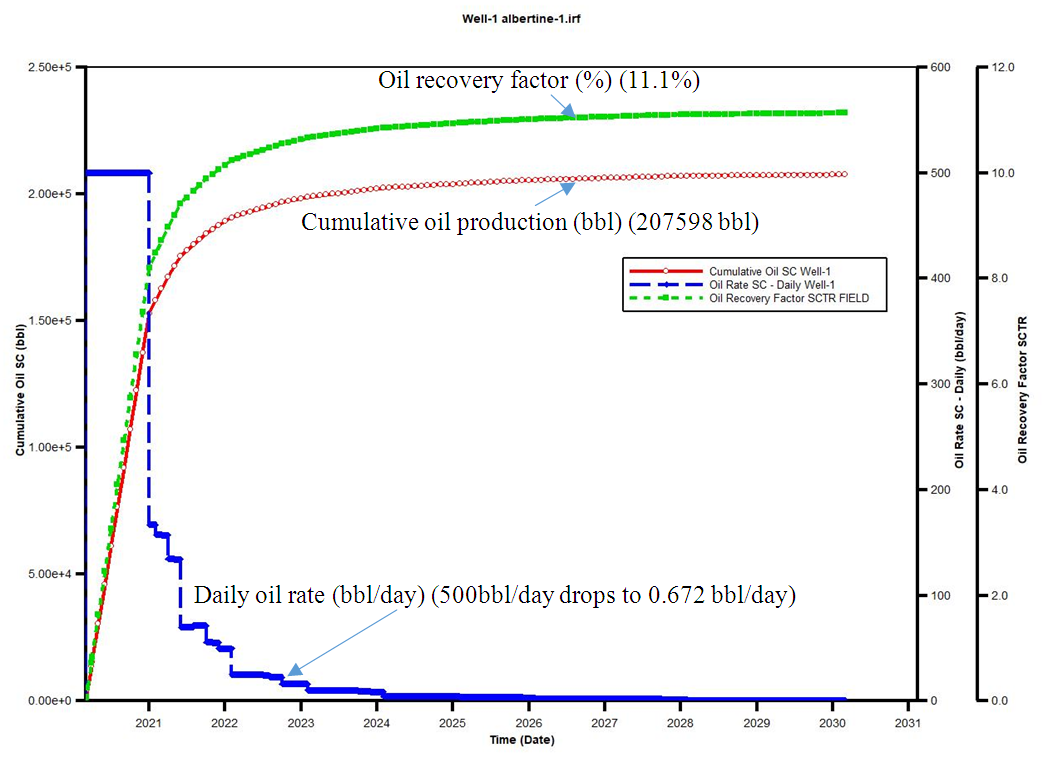 | Figure 2. Prediction of daily oil production rate, cumulative oil production, and Oil recovery factor during primary production. (Obtained some data from Rafael et al. 2012) |
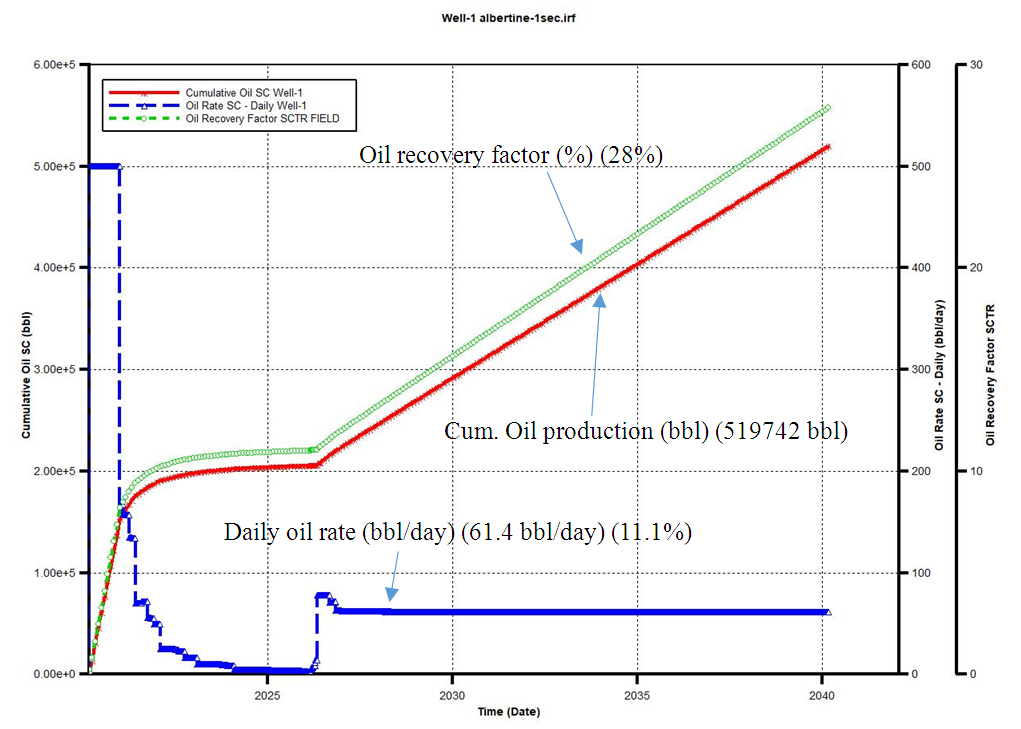 | Figure 3. Prediction of daily oil production rate, cumulative oil production, and oil recovery factor during secondary production. (Obtained some data form Rafael et al. 2012) |
 | Figure 4. Oil production future prospects based on revenue and oil value |
 | Figure 5. Energy demand by different sectors |
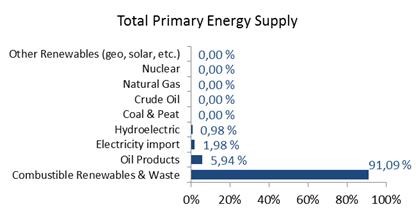 | Figure 6. Energy use based on supply in Uganda |
 | Figure 7. Charcoal burning as an energy source in Uganda |
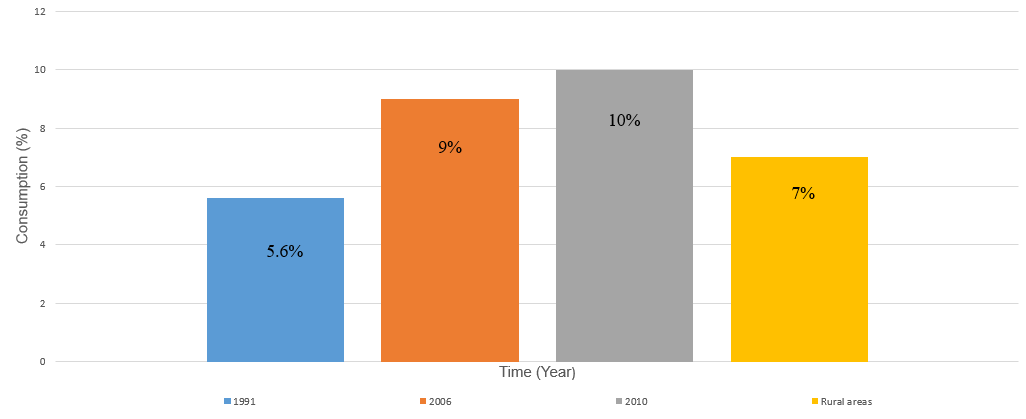 | Figure 8. Electricity consumption over years in urban areas as compared with rural areas presently |
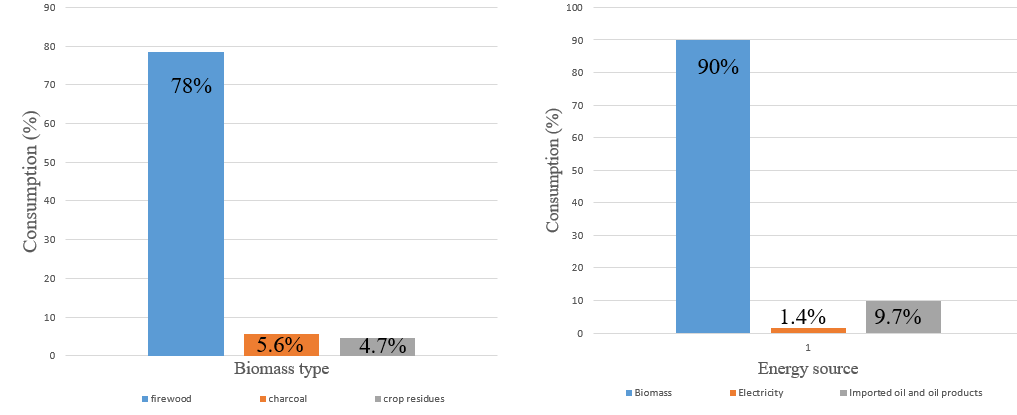 | Figure 9. Biomass types mainly consumed in Uganda and energy use comparison |
4. Conclusions
The review has analysed different energy sources currently available in Uganda and the future energy prospects the country has undertaken. Underlying opportunities in the energy sector were explored through analysing individual subsectors and the future predictions of the currently discovered fossil fuel resource were made based on a simulation model. Nevertheless, the energy sector in Uganda is still dominated by the renewable resources with firewood and charcoal taking the upper hand mainly used for cooking purposes, followed by electricity from hydro-power which has seen a boast with the introduction of the rural electrification program to reach out the villages. The oil sector is expected to boost the country’s economy with 280000 barrels per day in 2040 the natural gas produced of which would contribute to the country’s overall energy base. Biomass still remains the country’s main source of energy with firewood mainly consumed. However, green energy technology need to be devised through effective development of the geothermal reservoirs to yield geothermal energy. Energy security is an important parameter that developed countries have utilized to set pace for green energy promotion, Uganda could also base on this to improve on the energy standards. Future research should focus on methods of attaining green energy through an era dominated by natural gas and new energy alternatives utilizing geothermal energy. The need for renewable energy in Uganda has been highlighted through comparison of future demands of fossil fuels and the renewable energy resources. The simulation study of the discovered fossil fuel in Uganda predicts future oil extinction thereby acting as a pivotal point for further research on affordable and renewable energy resources which are environmentally friendly with zero pollution.Uganda should accelerate the development of renewable energy resources especially geothermal and solar energy in order to solve the environmental issues associated with greenhouse gas emissions from the fossil fuels. This also saves the rampart cutting of trees for burning and substantially drags Uganda to a new energy era.
References
| [1] | Alfred Wandera, and Samuel Sanya (31 March 2015). "20MW of solar energy to be added to national grid". New Vision. Kampala. Retrieved 2 March 2018. |
| [2] | Ezra Suruma, (2010). Oil discoveries in Uganda: a blessing or a curse. Published in brookings on Tuesday, May 18, 2010. |
| [3] | http://ugbusiness.com/4432/era-increases-power-tariffs-for-first-three-months-of-2018. Retrieved on Thursday 14th June, 2018. |
| [4] | John Hassler, Per Krusell, Abdulaziz Shifa, Daniel Spiro, 2013. Ugandan oil-a blessing or curse? |
| [5] | Godfrey Bahati and Agnes Alaba, (2008). Geothermal energy potential of Uganda. Department of geological survey and mines, Entebbe, Uganda. |
| [6] | C.Y. Cynthia Lin, (2011). Estimating supply and demand in the world oil market. Volume 34, Number 1.published in the journal of energy and development. |
| [7] | Brieland Jones. (2015). Social and Environmental impacts of charcoal production in Liberia. Graduation thesis. University of Michigan. |
| [8] | Muloni, Irene (2012). "Uganda's Renewable Energy Investment Guide 2012" (PDF). Embassy of the Netherlands in Uganda. Retrieved 14 April 2018. |
| [9] | Ulie Magnihild Grøtnæs, Trond Kvarsvik, Ingvild Bergskaug, and Svein Erik Heglund (2 July 2014). "The Oil for Development Programme in Uganda". Norwegian Agency for Development Cooperation. Retrieved 31 April 2018. |
| [10] | http://www.theworldfolio.com/news/irene-muloni-minister-of-energy-mineral-development-uganda/3362/. Retrieved Thursday 14th June, 2018. |
| [11] | Chester L, (2010). Conceptualizing and measuring energy security: a synthesized approach. http://dx.doi.org/10.1016/j.enpol. |
| [12] | Bradshaw MJ, (2010). Global energy dilemmas: a geographical perspective. http://dx.doi.org/10.1111/j.1475-4959.2010.00375.x. |
| [13] | Kuik OJ, Lima MB, Gupta J., (2011). Energy security in a developing world. Wiley Interdiscip Rev Clim Change. http://dx.doi.org/10.1002/ wcc.118. |
| [14] | Ministry of energy and mineral development, Uganda. The energy policy for Uganda (pdf). |
| [15] | Saundry Peter (15 July 2009). "Energy Profile of Uganda". Eoearth.org. Archived from the original on 9 June 2015. Retrieved 31 April 2018. |
| [16] | Bariyo Nicholas (15 April 2013). "Uganda Reaches Deal on Refinery, Pipeline". Wall Street Journal. Retrieved 15 April 2018. |
| [17] | http://eprcug.org/research/research-series/388-the-challenges-of-macroeconomic-management-of-natural-resource-revenues-in-developing-countries-the-case-of-uganda. Retrieved on Thursday 14th June 2018. |
| [18] | https://www.iea.org/topics/energysecurity/whatisenergysecurity/. Retrieved on Thursday 14th June 2018. |
| [19] | International Energy Agency (IEA). World energy outlook. Paris: International Energy Agency; 2011. |
| [20] | https://www.iea.org/topics/energysecurity/whatisenergysecurity/. Retrieved Thursday 14th June 2018. |
| [21] | Sarah Nafuna Mudoko, (2013). Uganda’s policy on energy and power. Paper presented at JICA training on energy policy, Tokyo Japan, from 2-22, June, 2013. |
| [22] | Biryabarema, Elias (17 February 2015). "Uganda Picks Russia's RT Global Resources To Build Refinery". London: Reuters. Retrieved 15 January 2018. |
| [23] | Musisi, Frederic (4 December 2017). "Uganda requests to join OPEC". Daily Monitor. Kampala. Retrieved 4 December 2017. Graduation thesis, imperial college of London. |
| [24] | Rafael J. Kaczmarczyk, (2012). Approximation of primary, secondary, and tertiary recovery factors in viscous oil reservoirs deposited in Ugandan sands. |
| [25] | https://www.planete-energies.com/en/medias/feature-reports/what-are-differences-between-fossil-fuels-and-renewable-energies. |
| [26] | Biryabarema, Elias (10 December 2014). "Four Firms to Build 20 MW Solar Power Plants in Uganda". Reuters.com. Retrieved 15 April 2018. |
| [27] | Fortuneofafrica.com/ug/energy-sector-profile-in-uganda/. Retrieved on 2018/04/26. |
| [28] | Oting William Kamis Avellino, Fridah Mwarania, Al-Hassan Abdul Wahab, Kpatinde Talagbe Aime, 2018. Uganda solar energy utilization: Current status and future trends. Published in international journal of scientific and research publications, volume 8, issue 3, March 2018. DOI: 10.29322/IJSRP.8.3. 2018.p7547. |
| [29] | O. Broad and M. Hankins, 2015. “ENERGY REPORT FOR UGANDA A 100 % RENEWABLE,”. |
| [30] | H. E. Trends, 2007. Future trends in energy, climate and wood fuel use,” pp. 25–32. |




 is the total summation of the energy supply at time t, n is the number of the exporting countries, m is the number of importing countries, x is the energy importer and y is the energy exporter,
is the total summation of the energy supply at time t, n is the number of the exporting countries, m is the number of importing countries, x is the energy importer and y is the energy exporter,  are the existing proven reserves at time t,
are the existing proven reserves at time t,  is the output of energy for the importer or exporter., Pt is the energy price, Rdt is the risk factor and Rnst is the non-systematic risk factor.
is the output of energy for the importer or exporter., Pt is the energy price, Rdt is the risk factor and Rnst is the non-systematic risk factor.  is the total summation of the energy demand at time t.To analyse the energy security based on the supply side, the following dimensions are considered, time span, fuel variety, proved reserves, and quantitative volume, on the basis of the hydrocarbon resources. To bring other energy sources into play, the government of Uganda should aim at integrating the above dimensions with respect to the time span through, conserving the energy efficiency, building strategic hydrocarbon reserves, diversifying imports to bring in other renewable sources to the country, and effective management of the market.
is the total summation of the energy demand at time t.To analyse the energy security based on the supply side, the following dimensions are considered, time span, fuel variety, proved reserves, and quantitative volume, on the basis of the hydrocarbon resources. To bring other energy sources into play, the government of Uganda should aim at integrating the above dimensions with respect to the time span through, conserving the energy efficiency, building strategic hydrocarbon reserves, diversifying imports to bring in other renewable sources to the country, and effective management of the market.








 Abstract
Abstract Reference
Reference Full-Text PDF
Full-Text PDF Full-text HTML
Full-text HTML





